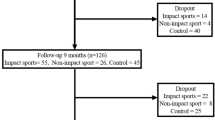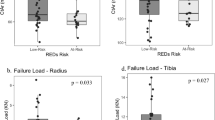Abstract
Bone health is considered not to benefit from water-based sports because of their weight-supported nature, but available evidence primarily relies on DXA technology. Our purpose was to investigate musculoskeletal health in the upper and lower body in well-trained adolescent female athletes using pQCT and compare these athletes with less-active, age- and sex-matched peers. Bone mineral content, volumetric cortical and trabecular BMD, total and cortical area, and bone strength index were assessed at the distal and proximal tibia and radius in four groups of adolescent females (mean age, 14.9 years) including water polo players (n = 30), gymnasts (n = 25), track-and-field athletes (n = 34), and nonactive controls (n = 28). Water polo players did not show any benefit in bone strength index or muscle size in the lower leg when compared with controls. In contrast, gymnasts showed 60.1 % and 53.4 % greater bone strength index at the distal and proximal tibia, respectively, than nonactive females (p < 0.05). Similarly, track-and-field athletes displayed 33.9 % and 14.7 % greater bone strength index at the distal and proximal tibia, respectively, compared with controls (p < 0.05). In the upper body, water polo players had 31.9 % greater bone strength index at the distal radius, but not the radial shaft, and 15.2 % larger forearm muscle cross-sectional area than controls (p < 0.05). The greatest musculoskeletal benefits in the upper body were found in gymnasts. In conclusion, despite training at an elite level, female water polo players did not show any benefits in musculoskeletal health in the lower leg and only limited benefits in the upper body when compared with nonactive girls.

Similar content being viewed by others
References
Oja P, Titze S, Bauman A, de Geus B, Krenn P, Reger-Nash B, Kohlberger T (2011) Health benefits of cycling: a systematic review. Scand J Med Sci Sports 21:496–509
Chase NL, Sui X (2008) Comparison of the health aspects of swimming with other types of physical activity and sedentary lifestyle habits. Int J Aquat Res Educ 2:151–161
Chase NL, Sui X, Blair SN (2008) Swimming and all-cause mortality risk compared with running, walking, and sedentary habits in men. Int J Aquat Res Educ 2:213–223
Burr DB (1997) Muscle strength, bone mass, and age-related bone loss. J Bone Miner Res 12:1547–1553
Frost HM (2000) Muscle, bone, and the Utah paradigm: a 1999 overview. Med Sci Sports Exerc 32:911–917
Ferry B, Duclos M, Burt L, Therre P, Le Gall F, Jaffre C, Courteix D (2011) Bone geometry and strength adaptations to physical constraints inherent in different sports: comparison between elite female soccer players and swimmers. J Bone Miner Metab 29:342–351
Magkos F, Kavouras SA, Yannakoulia M, Karipidou M, Sidossi S, Sidossis LS (2007) The bone response to non-weight-bearing exercise is sport-, site-, and sex-specific. Clin J Sport Med 17:123–128
Risser WL, Lee EJ, LeBlanc A, Poindexter HB, Risser JM, Schneider V (1990) Bone density in eumenorrheic female college athletes. Med Sci Sports Exerc 22:570–574
Taaffe DR, Snow-Harter C, Connolly DA, Robinson TL, Brown MD, Marcus R (1995) Differential effects of swimming versus weight-bearing activity on bone mineral status of eumenorrheic athletes. J Bone Miner Res 10:586–593
Block JE, Friedlander AL, Brooks GA, Steiger P, Stubbs HA, Genant H (1989) Determinants of bone density among athletes engaged in weight-bearing and non-weight-bearing activity. J Appl Physiol 67:1100–1105
Courteix D, Lespessailles E, Peres SL, Obert P, Germain P, Benhamou CL (1998) Effect of physical training on bone mineral density in prepubertal girls: a comparative study between impact-loading and non-impact-loading sports. Osteoporos Int 8:152–158
Dook JE, James C, Henderson NK, Price RI (1997) Exercise and bone mineral density in mature female athletes. Med Sci Sports Exerc 29:291–296
Duncan CS, Blimkie CJ, Kemp A, Higgs W, Cowell CT, Woodhead H, Briody JN, Howman-Giles R (2002) Mid-femur geometry and biomechanical properties in 15- to 18-yr-old female athletes. Med Sci Sports Exerc 34:673–681
Taaffe DR, Marcus R (1999) Regional and total body bone mineral density in elite collegiate male swimmers. J Sports Med Phys Fitness 39:154–159
Jacobson PC, Beaver W, Grubb SA, Taft TN, Talmage RV (1984) Bone density in women: college athletes and older athletic women. J Orthop Res 2:328–332
Nikander R, Sievanen H, Uusi-Rasi K, Heinonen A, Kannus P (2006) Loading modalities and bone structures at nonweight-bearing upper extremity and weight-bearing lower extremity: a pQCT study of adult female athletes. Bone (NY) 39:886–894
Shaw CN, Stock JT (2009) Habitual throwing and swimming correspond with upper limb diaphyseal strength and shape in modern human athletes. Am J Phys Anthropol 140:160–172
Norton KI, Olds TS (1996) Anthropometrica. University of New South Wales Press, Sydney
Tanner JM (1962) Growth at adolescence. Blackwell, Oxford
Duke PM, Litt IF, Gross RT (1980) Adolescents’ self-assessment of sexual maturation. Pediatrics 66:918–920
Fielsler CM (2001) The female runner. In: O’Connor FG, Wilder RP (eds) Textbook of running medicine. McGraw-Hill, New York, pp 435–446
Aaron DJ, Kriska AM, Dearwater SJ, Cauley JA, Metz KF, LaPorte RE (1995) Reproducibility and validity of an epidemiologic questionnaire to assess past year physical activity in adolescents. Am J Epidemiol 142:191–201
Creighton DL, Morgan AL, Boardley D, Brolinson PG (2001) Weight-bearing exercise and markers of bone turnover in female athletes. J Appl Physiol 90:565–570
Hind K, Gannon L, Whatley E, Cooke C, Truscott J (2011) Bone cross-sectional geometry in male runners, gymnasts, swimmers and non-athletic controls: a hip-structural analysis study. Eur J Appl Physiol 112(2):535–541
Lee EJ, Long KA, Risser WL, Poindexter HB, Gibbons WE, Goldzieher J (1995) Variations in bone status of contralateral and regional sites in young athletic women. Med Sci Sports Exerc 27:1354–1361
Nikander R, Kannus P, Dastidar P, Hannula M, Harrison L, Cervinka T, Narra NG, Aktour R, Arola T, Eskola H, Soimakallio S, Heinonen A, Hyttinen J, Sievanen H (2009) Targeted exercises against hip fragility. Osteoporos Int 20:1321–1328
Silva CC, Goldberg TB, Teixeira AS, Dalmas JC (2011) The impact of different types of physical activity on total and regional bone mineral density in young Brazilian athletes. J Sports Sci 29:227–234
Nikander R, Sievänen H, Heinonen A, Kannus P (2005) Femoral neck structure in adult female athletes subjected to different loading modalities. J Bone Miner Res 20:520–528
Orwoll ES, Ferar J, Oviatt SK, McClung MR, Huntington K (1989) The relationship of swimming exercise to bone mass in men and women. Arch Intern Med 149:2197–2200
Heinrich CH, Going SB, Pamenter RW, Perry CD, Boyden TW, Lohman TG (1990) Bone mineral content of cyclically menstruating female resistance and endurance trained athletes. Med Sci Sports Exerc 22:558–563
Liu L, Maruno R, Mashimo T, Sanka K, Higuchi T, Hayashi K, Shirasaki Y, Mukai N, Saitoh S, Tokuyama K (2003) Effects of physical training on cortical bone at midtibia assessed by peripheral QCT. J Appl Physiol 95:219–224
Courteix D, Lespessailles E, Obert P, Benhamou CL (1999) Skull bone mass deficit in prepubertal highly-trained gymnast girls. Int J Sports Med 20:328–333
Karlsson MK, Hasserius R, Obrant KJ (1996) Bone mineral density in athletes during and after career: a comparison between loaded and unloaded skeletal regions. Calcif Tissue Int 59:245–248
Ferry B, Duclos M, Burt L, Therre P, Le Gall F, Jaffre C, Courteix D (2011) Bone geometry and strength adaptations to physical constraints inherent in different sports: comparison between elite female soccer players and swimmers. J Bone Miner Metab 29:342–351
Acknowledgments
This research was kindly supported by the Australian Research Council and industry partners including the New South Wales Sporting Injuries Committee, New South Wales Institute of Sport, Athletics Australia, Gymnastics Australia and Water Polo New South Wales. The authors wish to thank the athletic participants who volunteered for this project as well as control participants from Santa Sabina College, Strathfield, New South Wales.
Conflict of interest
No author has a financial relationship with the funding organization that supported the research, or with any other organization whose area of activity may be affected or perceived to be influenced by the results of the study. Authors have full control of all primary data and agree to allow the journal to review our data if requested.
Author information
Authors and Affiliations
Corresponding author
About this article
Cite this article
Greene, D.A., Naughton, G.A., Bradshaw, E. et al. Mechanical loading with or without weight-bearing activity: influence on bone strength index in elite female adolescent athletes engaged in water polo, gymnastics, and track-and-field. J Bone Miner Metab 30, 580–587 (2012). https://doi.org/10.1007/s00774-012-0360-6
Received:
Accepted:
Published:
Issue Date:
DOI: https://doi.org/10.1007/s00774-012-0360-6




